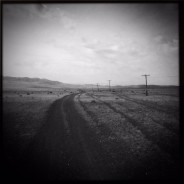
Uso de cookies
Este sitio web utiliza cookies para que usted tenga la mejor experiencia de usuario.
Si continúa navegando está dando su consentimiento para la aceptación de las mencionadas cookies y la aceptación de nuestra política de cookies.


9 September, 2015
Once you cross the Mongolian border, there is a stop sign. It is one of the very few traffic sign I will see across the road until I reach the capital, Ulan Bator.
A woman comes out running from a somewhat tattered shed, signalling me to stop. I need to pay two tolls, one for the motorcycle’s insurance (which originally was USD$50 but ended up paying USD$10) and another one of USD$5 for the right to drive through Mongolian roads. The latter you can’t negotiate. When she asks the latter toll, I laugh loudly. I may have woken Genghis Khan from his grave and the woman looks at me with a gesture of complicity. Nothing to be done here, you have to pay even though I have all my paperwork in order. If I don’t pay, I can’t continue.
Some days before this situation, I used my “sleep and notebook” tactic. This basically means that I will take the night to think about something when I’m not in a rush to make an important decision. This doesn’t mean I’ll be awake all night. It just means I will go to sleep with the problem in my head and with a notebook and pen next to me. In this case, I added the Mongolian roads map. In this way, I almost always get an idea to face a problem or take a decision.
Mongolia has two main roads, which they literally call the South Road and the North Road and then there are hundreds of smaller roads in between them at the centre. One of the decisions I had to take was which of these two main roads I was going to take. Both of them are solitary roads. Through either of them I would have to cross rivers. So I decided to go in between them first until I got to the Uureg Lake, then go South until I find the South Road, which goes through the Northern area of the Gobi desert, until I get to Ulan Bator. From that point onwards, I will take the Northern Road until I get to Russia.
Now I am in Ulan Bator, after more than 4 months of traveling. In these past few days the road has been particularly hard. It’s already cold, it rains and this makes it difficult to ride a bike along these roads because many of them are just dirt or mud, requiring driving skills I’m developing as I go along, in trials and errors.
Mongolian roads are also hard on the bike’s overall structure, but Athena has behaved well. She’s been dancing on top of rocks, sand and mud, albeit sometimes it would get dizzy and fall down. So, I am specializing in bike lifting when a bad rock or sand or mud patches make me fall. Every time I’m lifting the bike with more ease, so I reckon I will be able to participate in a strong man competition soon enough.
The Mongolian landscape is majestic with its unending plains crossed by roads where every car, truck or motorcycle draw their own tracks. Cruising it by bike has been a pleasure and a privilege. However, since Mongolia is one of the least populated countries in the world by population density, through many kilometers, the roads are completely solitary and it’s hard to come across someone. Sometimes you find some shepherds and their flocks, groups of camels or horses. The occasional sight of another vehicle could be a Mongol happily cruising on a Chinese motorcycle, at a mental speed, carrying all his family with him. Sometimes you also find a child running from his/her Ger to greet you or ask for candy if you carry any. These moments change completely the lonely routine of the journey.
The only company I have as I cruise the distance between small villages, usually 200-300km apart, are my thoughts. Because of that, I try to keep them positive. The unending rattle of the road, as if it was made by a tank, the vast deserted landscape and the sight of rusted, dismembered vehicles and their parts along the road dents my efforts at positivism.
From the dozens of tracks that form the road, it feels I keep on choosing the worst ones. But as I change to another track I realize that’s not true. Sometimes I look left and right at and notice another vehicle some 500m from me going very fast and I think that is the road I need to take and not the one I’m on. It’s easy to leave the main road because there is no road; just tracks and you need to have a good sense of direction to know where you’re going, especially in the middle of sand, rock and mud patches.
Along the journey I’ve found asphalt patches that stop abruptly as if they were being built km by km with every USD$5 note.
The final 500km to Ulan Bator are paved and constant. As I enter the capital, I find all the vehicles and people I have not seen along the previous journey. I face a monumental traffic jam.
My thoughts take me back to the vast Mongolian plains.
On the steppe and the desert, there are no traffic jams.
Hi Walter, how’s Ulan Bataar? I think you are very brave doing this trip. Reading your thoughts as you go along, observing internal and external landscapes, weather, creatures and road conditions brings to life that line between places connecting on your map. Buon proseguimento.
Oh, and, of course — gorgeous photographs